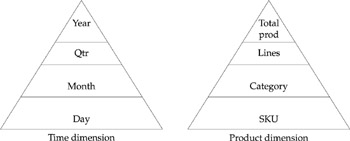Chapter 11: Multidimensional Analysis
|
| < Day Day Up > |
|
If you have designed a logical, business-oriented universe, designers need to do very little to provide users with multidimensional analysis capabilities. The power is mostly in the hands of the user at this stage. There is only minor tweaking for business users to do multidimensional analysis.
For WebIntelligence (WebI) users who access OLAP cubes, Business Objects recently released Universal Drill-Through Service (UDS). UDS allows you to drill from a summary MOLAP cube through to details in a relational database. It requires a bit more effort on the designer's part compared to standard multidimensional analysis within a BusinessObjects report; however, it is well-worth the effort given the seamless analysis UDS provides MOLAP users.
What Is Multidimensional Analysis?
As discussed in previous chapters, a dimension is often textual or time information by which users analyze numeric measures. Dimensional information may come from a lookup or reference table. Dimensions often have different levels or groupings associated with them called hierarchies. Figure 11-1 shows two sample dimensions.

Figure 11-1: The Time Dimension and the Product Dimension each have four levels that make up a hierarchy.
The levels or hierarchies allow users to analyze data by different groups. Some hierarchies, such as Time, are very clear-cut. As reviewed in the section 'Object Ordering' in Chapter 8, time objects typically go from Year to Quarter to Month to Week to Day. There is a natural order. Geography hierarchies may also be predetermined, starting with Continent, Country, State. However, when the geography applies to a marketing region, each company introduces its own variation. One company may group the Middle East and Africa together; another company may include Mexico as part of North America because it is part of NAFTA. Ideally, all these groupings should be agreed upon during your data warehouse design process and built into the dimension tables. However, as the universe designer, you may find that certain business units may want to view information according to different groupings. When the groupings change, do you provide users with the old grouping or new grouping or both?
For example, in Chapter 9, Table 9-2, you created a new product line, Jewelry. When you analyze historical sales at the product line level, do you analyze those products as if they were still part of Accessories, or part of the new line, Jewelry?
|
| < Day Day Up > |
|
EAN: 2147483647
Pages: 206